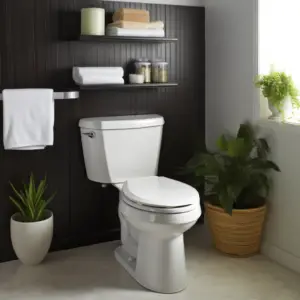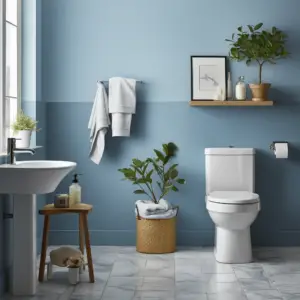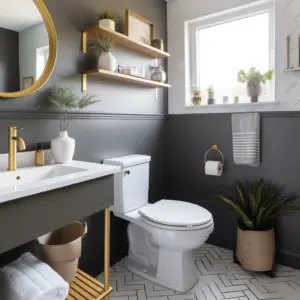Replacing a toilet can seem like a big job. But, with the correct guidance, it can be simple! We’ll show you step-by-step how to change your old toilet for a new one.
First, gather the tools and materials you need. These include a wrench, screwdriver, plunger, putty knife, wax ring, and the new toilet. Also, turn off the water supply.
Empty the tank and bowl of any remaining water with a towel or sponge. Then detach the water supply line and take off the nuts that secure the toilet to the floor. Lift off the old toilet and set it aside.
It’s time for the fun part: Installing the new toilet! Put a wax ring on the flange on the floor. This will make a watertight seal between the toilet and the drainage pipe. Carefully lower the toilet onto the wax ring and make sure it’s aligned with the bolts on the floor flange.
Tighten the bolts evenly, but not too tight, as it might crack the new toilet. Then reconnect the water supply and turn on the water valve. Flush the toilet several times to check for leaks or strange sounds. If it works, you’ve changed your old toilet!
My friend John was a little unsure about replacing the fixtures in his bathroom. But, he followed instructions online and swapped out his old toilet for a new one. Now, every time he uses the bathroom, he takes pride in the job he did.
Replacing a toilet may seem difficult, but with the right tools and instructions, it’s manageable. So, if you want to give your bathroom a makeover, just follow our guide and replace your toilet!
Table of Contents
Gathering the necessary tools and materials

Replacing a toilet successfully requires gathering all essential tools and materials. Here’s a guide on what to get:
- Take measurements of your current toilet to pick the right replacement size.
- Buy a new toilet that fits your measurements and meets your preferences.
- Have a wrench for disconnecting the water supply line from the old toilet.
- Have a bucket or towels to catch any leaking water.
- Put on disposable gloves to protect your hands.
Consider your specific needs, such as limited space in the bathroom. Double-check you got everything before starting the project.
Now you have everything needed. Time to upgrade the bathroom functionality and aesthetics! Follow our guide to replace the toilet successfully.
Preparing the area
To prepare the area for replacing a toilet, tackle the task with ease by focusing on removing the old toilet and cleaning the flange and drain. By following these sub-sections, you’ll be on your way to successfully replacing your toilet with confidence.
Removing the old toilet
- Turn off the water. Find the shut-off valve behind the toilet and turn it clockwise.
- Flush the toilet to drain water.
- Soak up remaining water with towels or a sponge.
- Unscrew the nut to disconnect the water supply line. Use adjustable pliers or a wrench. Be prepared for some leakage.
- Locate and remove the nuts, securing the toilet base to the floor. Use a wrench to loosen them counterclockwise.
- Lift and tilt the old toilet forward. Release it from its wax ring seal. Set it aside.
- Remove any wax residue from the floor flange and bottom of the toilet. Ensure surfaces are clean.
- Time to upgrade your bathroom! Get a stylish new fixture that suits your needs. Enjoy a rejuvenating experience with a perfect upgrade!
Cleaning the flange and drain
To keep your flange and drain in tip-top shape, here are some steps to take:
- Clear away any debris with gloves and a brush. Be careful not to scratch the surface.
- Sanitize the area with a commercial cleaner or a mixture of vinegar and baking soda. Let it sit for a few minutes before rinsing with warm water.
- Check for any blockages. A plunger or snake can help unclog if needed.
In addition, remember to regularly clean and avoid putting grease or large objects down the drain.
A friend once experienced a clogged drain which resulted in a flooded bathroom. He learnt the importance of regular cleaning and maintenance – a lesson we should all take to heart!
Installing the new toilet
To successfully install the new toilet, follow these steps: Place the wax ring on the flange, set the toilet bowl onto the wax ring, secure the toilet bowl to the floor, and attach the tank to the bowl. Each sub-section will be explained in detail to ensure you complete the installation efficiently and effectively.
Placing the wax ring on the flange
- Prepare the flange: Clean and fasten it securely to the floor. Tighten any loose screws.
- Center the wax ring: Put it on top of the flange. Make sure the cone-shaped side is facing up and the flat side is down.
- Apply pressure: Push down firmly, but not too hard.
- Check alignment: Check if the toilet bowl aligns with any bolt holes. Adjust if needed.
- Securely place toilet bowl: Carefully lower the bowl and press down to compress the wax ring.
Tips for optimal results:
- Use a thick wax ring if needed.
- Replace old or damaged rings.
- Use plumber’s putty around the base.
By following these steps, you will install your new toilet with a reliable seal that won’t leak.
Setting the toilet bowl onto the wax ring

Prepare the Toilet Bowl:
- Place the wax ring on the flange.
- Line it up with the center hole.
- Gently press down on the toilet bowl.
Position the Toilet Bowl:
- Lift the toilet bowl.
- Carefully lower it onto the wax ring.
- Ensure the mounting bolts line up with the holes in the base.
Secure the Toilet Bowl:
- Apply equal pressure on both sides of the toilet bowl.
- Compress and seal the wax ring.
- Tighten the mounting bolts by hand, without overtightening.
Plus, check the stability of the toilet bowl. Gently rock it after installation, without compromising the seal.
Pro Tip: Inspect both surfaces for any debris or damage before setting. This will help ensure a proper seal.
Securing the toilet bowl to the floor
- Clean the floor and get rid of any debris or old wax ring pieces.
- Put a new wax ring on the flange, centering it properly.
- Gently lower the toilet bowl onto the wax ring, lining it up with the flange bolts.
- Squeeze the wax ring by pressing evenly on both sides of the bowl.
- Hand-tighten the nuts onto the flange bolts, alternating between each side.
- Then use a wrench to give each nut a quarter-turn until snug.
For the best results, use a level to check the alignment and adjust as needed. Remember that incorrect installation can cause leaks and unsteady toilets!
Fun fact: Toilets have been around for centuries. Ancient civilizations used stone and clay fixtures connected to drain systems. So when you put in your new toilet, you’re following in the footsteps of history!
Attaching the tank to the bowl
To attach the tank and bowl, follow three easy steps!
- Position it: Put the tank on the bowl making sure it sits level and secure.
- Insert bolts: Put the provided bolts through the mounting holes, using washers and nuts to make them tight.
- Tighten: Use an adjustable wrench or pliers to tighten all the nuts. Don’t overtighten or you could damage the toilet.
Once you’ve done that, your toilet is ready to use. Check for any leaks before you use it regularly. Different models may have different attachment methods. Follow the manufacturer’s instructions for the best results.
When I did this in my home, I had some issues with the alignment. So, it was hard to put the bolts in smoothly. However, I managed it with patience and perseverance. It felt great doing it all by myself.
Testing and finishing touches
To ensure a successful completion of testing and finishing touches in replacing a toilet, implement these steps: checking for leaks and caulking around the base of the toilet. Each sub-section plays a crucial role in the final assessment and preservation of your newly installed toilet.
Checking for leaks
A key part of completion is to check for leaks. This involves thoroughly examining joints, seals and connections for any leakage. Doing this before finishing is fundamental to avoid issues later.
- Examine all connections.
- Check joints and seals.
- Scan for water or gas stains.
- Ensure that everything is sealed and fitted properly.
It’s also important to check that all parts are in working order after the leak check. This includes valves, pipes and other equipment related to the system tested. Not noticing leaks can cause big issues and might need costly repairs or replacement.
An example of this importance is the 2015 building project. The construction company hadn’t done a proper leak check before handing it over. This led to multiple apartments getting water damage soon after occupation. This shows how vital leak checks are to guarantee quality and prevent future issues.
Caulking around the base of the toilet

- Clean the area around the toilet base and remove any dirt or debris.
- Put painter’s tape along the edges for clean lines and no mess.
- Cut the tip of the caulking tube at a 45-degree angle and put it in a caulk gun.
- Squeeze a thin, even bead of caulk around the base, starting from one side and working your way around.
- Smooth the caulk with your finger or a tool.
- Choose a silicone caulk that is mold and mildew resistant.
- Let the caulk dry before using the toilet again.
- Check for gaps or cracks and recaulk regularly.
- This will stop water damage, keep the bathroom clean, and extend the life of the fixtures.
- So get your supplies ready and give your toilet that professional finish it needs.
Conclusion
Wrapping up this informative guide – carefully plan and pay attention to detail to replace a toilet. Follow the steps in this article for homeowners to confidently take on this home improvement project. Also, maintenance and regular inspections are key for any toilet’s longevity. A well-functioning toilet makes a home more comfortable and functional.
Let’s explore some unique details not previously discussed. Replacing a toilet may seem intimidating, but it can also be a chance to upgrade your bathroom’s style and efficiency. Modern toilets come with features like dual-flush mechanisms that save water and reduce your eco-footprint and bills. Quality materials like porcelain or ceramic guarantee durability and simple cleaning.
I remember a friend’s story who decided to replace their old toilet after years of hassles. Leaks appeared despite repair attempts. With determination (and some apprehension) they began their DIY mission. Armed with research and our tips, they succeeded in installing the new toilet without any issues. The result? Pride and relief. Problem solved!
Frequently Asked Questions
Question 1: Can I replace a toilet on my own?
Answer: Yes, you can replace a toilet on your own if you have basic DIY skills and follow the necessary safety precautions.
Question 2: What tools do I need to replace a toilet?
Answer: You will need a few tools including a wrench, plunger, putty knife, adjustable pliers, and a bucket.
Question 3: How long does it take to replace a toilet?
Answer: The time it takes to replace a toilet can vary depending on your experience level, but on average it takes about 1-2 hours.
Question 4: Can I reuse the old toilet wax ring?
Answer: It is generally recommended to replace the old wax ring with a new one to ensure a proper seal and avoid any potential leaking issues.
Question 5: Do I need to shut off the water supply before replacing a toilet?
Answer: Yes, it is important to shut off the water supply to the toilet before starting the replacement process to prevent water damage.
Question 6: Are there any safety precautions I should take while replacing a toilet?
Answer: Yes, make sure to wear protective gloves and eyewear, use caution when handling heavy parts, and follow the manufacturer’s instructions for safe installation.